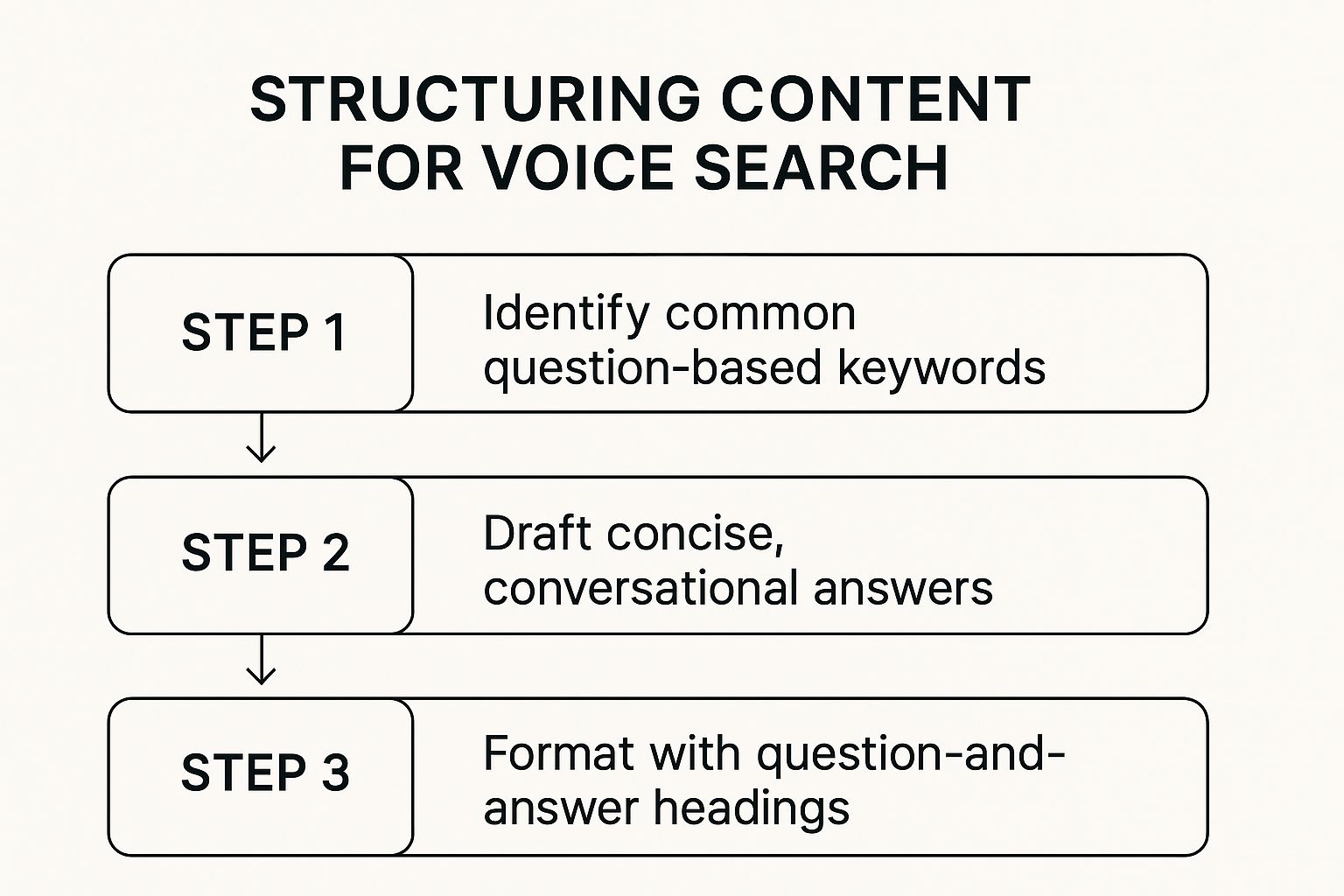how to optimize for voice search, voice search SEO, local voice search, conversational keywords, technical SEO
How to Optimize for Voice Search: Essential Strategies
Written by LLMrefs Team • Last updated August 18, 2025
Optimizing for voice search is all about shifting your mindset. You need to structure your content to answer the kinds of questions people actually speak, not just the fragmented keywords they type. It’s also about making sure your site is technically solid, delivering those answers quickly, especially on mobile.
The focus moves from short, choppy keywords to long-tail, question-based phrases—the exact way real people talk.
Why Voice Search Is Your Next Big Opportunity
Voice search isn't some far-off concept anymore; it's here, and it’s a massive part of how people find things online. The rise of smart speakers and mobile assistants has completely changed the game. People aren't typing "pizza Boston" into a search bar. They’re asking, "Hey Google, where can I get the best deep-dish pizza near me that's open late?"
If your content isn't built to answer that kind of specific, conversational question, you're essentially invisible to a huge and growing audience. It's time to think beyond the keyboard.
The Data Behind the Shift
The numbers don't lie. Voice search has woven itself into the fabric of the internet.
- Nearly 50% of online searches are now happening through voice assistants like Siri, Alexa, and Google Assistant.
- A staggering 71% of users actually prefer to ask a question out loud rather than type it.
- Most importantly for many businesses, 58% of these voice searches have local intent, making it a goldmine for capturing nearby customers.
Voice assistants don't give you a page of ten blue links. They give you one answer. Your goal is to be that single, definitive answer. That’s how you become the go-to authority.
To help you get there, let's break down the core components of a solid voice search strategy.
Core Pillars of Voice Search Optimization
This table summarizes the essential areas you need to focus on to successfully optimize your website for voice search queries.
| Pillar | Key Focus | Example Action |
|---|---|---|
| Conversational Content | Answering questions naturally | Create FAQ pages that directly address "who," "what," "where," and "how" questions. For example, a roofer could answer, "How much does a new roof cost in Texas?" |
| Technical SEO | Speed and mobile-friendliness | Use a tool like TinyPNG to compress your images and a CDN like Cloudflare to ensure your site loads in under 3 seconds. |
| Local SEO | Capturing "near me" traffic | Keep your Google Business Profile updated with current hours, address, and photos of your storefront. |
| Structured Data | Helping search engines understand content | Implement Recipe schema for a food blog, so Google can pull out cooking times and ingredients for voice assistants. |
Each of these pillars plays a critical role in positioning your site as the best possible answer for a spoken query.
A Roadmap for Success
Getting your site ready for voice search involves a bit of everything, from the words you write to the technical details under the hood. This guide will give you a clear roadmap to turn your website into a voice-friendly powerhouse that both users and search engines will love.
Of course, this is all part of a bigger picture. To really get ahead, you need to see how voice fits into the evolution of search, which is why learning about AI search optimization is so valuable. For more hands-on advice, this guide offers some excellent voice search SEO tips to get you started.
Mastering Conversational Content for Spoken Queries

To win at voice search, you have to unlearn a core habit of traditional SEO: moving beyond short, choppy keywords. People simply don't speak the way they type. Your content strategy has to mirror this fundamental shift in behavior by adopting a much more natural, conversational tone.
Think about the difference for a second. A typed query might be "best deep-dish pizza NYC." A spoken query, however, sounds more like, "Hey Siri, where can I find the best deep-dish pizza near me that's open late?" That second query is longer, more specific, and structured like a real question. This is the new battlefield for visibility.
Finding The Questions People Actually Ask
Your first move is to figure out the long-tail, question-based phrases your audience is actually using. Forget the guesswork; use data to guide your content creation. Great content anticipates and answers questions, positioning you as an authority.
Actionable Tip: Go to Google and type in a core service you offer, like "financial planning." Scroll down to the "People Also Ask" box. You'll see questions like "What are the first steps to financial planning?" and "How much money should I have saved by 30?" These are the exact questions you need to answer.
Let's look at a real-world scenario. A company selling eco-friendly cleaning supplies might traditionally target a keyword like "natural all-purpose cleaner." For voice search, their research would likely uncover questions like these:
- "What is the best natural cleaner for kitchen counters?"
- "How do you make a non-toxic bathroom cleaner at home?"
- "Are eco-friendly cleaners safe for pets?"
Each of these questions is a perfect opportunity for a targeted blog post, a dedicated FAQ section, or a detailed how-to guide. This approach aligns your content directly with the exact language of a spoken search.
Structuring Content for Direct Answers
Once you've identified your target questions, the next step is structuring your content to provide clear, immediate answers. Voice assistants don't have the patience to dig through dense paragraphs—they need to find the answer fast and read it back to the user.
This is where formatting becomes your secret weapon. Use the question itself as a heading (like an H2 or H3) and provide a concise, direct answer right below it.
Practical Example: If the question is "How often should I water a succulent?", structure your content like this:
How often should I water a succulent?
Succulents should be watered approximately every 10-14 days. It's crucial to let the soil dry out completely between waterings to prevent root rot.
This structure makes it incredibly easy for search engine crawlers to identify the query-and-answer pair.
Pro Tip: Aim for answers that are around 29 words long. Research shows this is the average length of a voice search result snippet. Keep your language simple and direct, ideally written at a 9th-grade reading level, to make it accessible to everyone.
This approach not only sets you up for voice search success but also dramatically increases your chances of capturing a featured snippet—that coveted "Position Zero" answer box in Google's results. Since voice assistants often read directly from these snippets, securing them is a top priority.
The financial incentive for getting this right is massive. The voice recognition market is projected to hit $26.8 billion by 2025, which shows just how commercially important this is becoming. This is precisely why your SEO strategy needs to evolve.
Build a Powerful FAQ Page
One of the most effective ways to target a wide range of spoken queries is by creating a comprehensive FAQ page. This single page can become a central hub, answering dozens of relevant user questions in one convenient place. It's an efficient way to target numerous long-tail keywords without having to create a separate article for every single one.
Actionable Insight: Organize your FAQ page with logical, clear headings for different categories (e.g., "Shipping & Returns," "Product Care," "Sizing"). Then, use a tool like an FAQ Schema generator to add the structured data that explicitly tells Google this page is a list of questions and answers.
To truly excel, it helps to understand the technology powering modern voice assistants. Exploring dedicated conversational AI services can give you a significant edge in crafting content that resonates with these sophisticated systems.
By embracing natural language and structuring your content to answer direct questions, you transform your website from a static resource into a helpful, conversational partner. This doesn't just prepare you for the continued rise of voice search; it improves the overall user experience for every single visitor, no matter how they find you.
How to Dominate Local Voice Search Results
 When someone uses voice search to find something, there’s a good chance they’re looking for a solution right now, right here. A massive slice of voice queries are inherently local. Users aren't just browsing; they're often on the move and ready to act, making local voice search an incredibly valuable source of high-intent traffic.
When someone uses voice search to find something, there’s a good chance they’re looking for a solution right now, right here. A massive slice of voice queries are inherently local. Users aren't just browsing; they're often on the move and ready to act, making local voice search an incredibly valuable source of high-intent traffic.
Capturing these "near me" searches isn't about some complex technical wizardry. It really boils down to paying close attention to your local digital footprint. The goal is simple: make it effortless for voice assistants to see your business as the most relevant, reliable, and convenient answer for a local query.
Your Google Business Profile is the Foundation
Your Google Business Profile (GBP) is, without a doubt, the single most important asset for local voice search. Voice assistants like Google Assistant and Siri pull information directly from this profile to answer questions about your hours, directions, and services. A neglected or incomplete profile is a huge missed opportunity.
Think of your GBP as your digital storefront. It needs to be pristine, accurate, and packed with information that answers a user's questions before they even think to ask them.
- Actionable Step: Go to your GBP dashboard and activate the "Messaging" feature. This allows customers to send you a text directly from your profile, a key signal of an engaged, modern business.
- Keep Your Hours Current: Nothing frustrates a potential customer more than driving to a business that's closed. Be diligent about updating your regular hours, holiday schedules, and any temporary closures.
- Be Specific with Categories: Choose the most precise primary category for your business, then add all relevant secondary categories. A restaurant should be an "Italian Restaurant" or "Pizza Restaurant," not just a generic "Restaurant."
A fully optimized Google Business Profile isn't just a suggestion; it's the bedrock of your local voice search strategy. Voice assistants trust this data implicitly, so every detail you provide increases your chances of being the top recommendation.
Nail Your NAP Consistency
Beyond your GBP, your business's Name, Address, and Phone number (NAP) has to be perfectly consistent everywhere on the web. Voice assistants cross-reference data from multiple online directories—think Yelp, TripAdvisor, and other industry-specific sites—to verify your information.
Practical Example: If your GBP lists your business as "Mike's Pizza Shop," but your Yelp profile says "Mike's Pizzeria," that's an inconsistency. You need to pick one version and use it everywhere, down to the last comma.
Imagine a user asks, "Find a bike repair shop near me." If Google finds three different phone numbers or two slightly different addresses for your shop online, it might just default to a competitor with cleaner, more consistent data. That’s why NAP consistency is non-negotiable.
Encourage and Engage with Local Reviews
Reviews are a powerful signal of trust and quality, and you can bet voice assistants are paying attention. A user asking, "What's the best-rated coffee shop near me?" is directly prompting the search engine to look at your review scores.
Actionable Tip: Don't just ask for reviews—make it easy. Create a simple QR code that links directly to your GBP review page. Print it on your receipts, display it at your checkout counter, or include it in follow-up emails.
Even more important: respond to every review, both positive and negative. Engaging with feedback shows that you value your customers and are an active, attentive business owner. This public engagement builds social proof that both humans and algorithms can see.
Weave Local Language into Your Content
Finally, let's bring your local optimization efforts home to your own website. Your on-page content should reflect the physical community you serve. This is how you capture the more specific, long-tail local voice queries that your competitors are probably missing.
Practical Example: A coffee shop in Chicago could create content targeting queries far more specific than "coffee shop Chicago."
- Generic: "We are a coffee shop in Chicago."
- Voice-Optimized: "Our cozy coffee shop, located in the Loop just a block from the Art Institute, is the perfect spot for a latte before you see the exhibits."
That small shift makes the business a top contender for a spoken query like, "Where can I get coffee by the Art Institute?" When you start thinking like a local, you optimize your content to answer the questions real people are asking, turning those voice searches into actual foot traffic.
Get Your Technical SEO Right for Voice Search
Creating conversational content is only half the battle. If your website's technical foundation isn't solid, even the best content will fall flat in voice search. Voice assistants are all about speed and efficiency—they won't bother with a slow, clunky website.
Getting these technical details right is non-negotiable. Search engines need to be able to crawl, interpret, and trust your site in an instant. A technically sound website signals authority and reliability, which is exactly what a voice assistant is looking for when sourcing an answer.
Prioritize Blazing-Fast Page Speed
Site speed isn't just a "nice-to-have." It’s a massive ranking factor, especially for voice search where people expect answers immediately. A slow-loading page is the quickest way to get ignored. The magic number? Aim for a load time under three seconds.
Here are actionable steps to make that happen:
- Compress Your Images: Use a tool like TinyPNG to shrink file sizes without losing visual quality. This is often the biggest and easiest speed win.
- Leverage Browser Caching: Configure your server to tell a user's browser to save static files (like your logo and CSS), so they don't have to be re-downloaded on every visit.
- Minimize HTTP Requests: Every script, image, and stylesheet is a separate request. Use a WordPress plugin like Autoptimize to combine CSS and JavaScript files automatically.
- Use a Content Delivery Network (CDN): A CDN stores copies of your site on servers globally. When a user visits, data is served from the nearest location, drastically cutting load times.
Master Schema Markup and Structured Data
Schema markup is basically a way to spoon-feed search engines information about your content. By adding specific tags to your HTML, you’re not just showing Google text and images; you're telling it, "Hey, this is a recipe," or "This is an FAQ page."
This is a goldmine for voice search. It allows a voice assistant to pull out a specific piece of data—like a cooking time or an event date—and serve it up as a direct answer. If there’s one thing to add to your technical SEO to-do list, it's learning how to add schema markup.
Practical Example: If you run a local event venue, you would use Event schema to mark up the event name, date, time, and location. When someone asks, "What time does the concert at The Fillmore start tonight?", Google can pull the answer directly from your schema.
This infographic breaks down how to structure your content so search engines can easily understand it, which is precisely what schema helps you do.

The image illustrates a clear process, from figuring out what users are asking to formatting the answers in a way that both people and algorithms can quickly digest.
Here is a quick checklist to help you stay on track with the key technical elements for voice search optimization.
Voice Search SEO Technical Checklist
| Technical Element | Why It Matters for Voice Search | How to Implement |
|---|---|---|
| Page Speed | Voice assistants need immediate answers. Slow pages get ignored. | Compress images, use a CDN, minimize code, and enable browser caching. |
| Schema Markup | It helps search engines understand context, making it easier to pull direct answers. | Use Google's Structured Data Markup Helper or a WordPress plugin like Rank Math to add schema for FAQs, articles, products, etc. |
| Mobile-First Design | Most voice searches happen on mobile. Your site must be flawless on a small screen. | Use Google's Mobile-Friendly Test to check your pages and identify specific usability issues like text that is too small to read. |
| HTTPS Security | Security builds trust with both users and search engines. It's a non-negotiable ranking signal. | Install an SSL certificate on your server. Many web hosts, like SiteGround or Bluehost, offer free Let's Encrypt SSL certificates. |
Focusing on these four pillars will give your content the technical support it needs to stand out.
Embrace a Mobile-First and Secure Website
It should come as no surprise that the vast majority of voice searches happen on mobile devices. This makes a mobile-friendly website absolutely critical. In fact, Google now uses mobile-first indexing, meaning it primarily looks at your site's mobile version to determine rankings.
Your site has to be fully responsive, adapting perfectly to any screen size. Text needs to be readable without pinching and zooming, and buttons have to be easy to tap with a thumb.
On top of that, security is a huge trust signal. Your site absolutely must use HTTPS to encrypt the data between a user's browser and your server. Browsers flag non-HTTPS sites as "Not Secure," which is an instant credibility killer and a surefire way to hurt your rankings.
By ticking these technical SEO boxes—speed, structured data, mobile-friendliness, and security—you're creating the perfect environment for your conversational content to shine. This meticulous approach is how you become the fast, reliable, and trustworthy source that voice assistants are programmed to find. This technical groundwork is also crucial for broader search trends, which is why getting a handle on AI search engine optimization offers a valuable look into the future.
Building the Kind of Authority Voice Assistants Trust

When someone asks a question, a voice assistant doesn't serve up a list of blue links. It gives a single, direct answer. To be that answer, your website has to signal absolute authority and trustworthiness.
This is about more than just keywords. It’s about building a reputation that tells search engines you’re the definitive source—the real expert in your field.
E-E-A-T Is Your North Star
The bedrock of this authority is Google's E-E-A-T framework. Think of Experience, Expertise, Authoritativeness, and Trustworthiness as the criteria voice assistants use to vet potential answers.
- Experience: Show, don't just tell. Instead of saying you're a travel expert, write a trip report with your own photos and specific tips from a place you actually visited.
- Expertise: Include author bios on your blog posts that list credentials, certifications, or years of experience. This directly signals expertise.
- Authoritativeness: Are other credible people in your industry linking to and referencing your work?
- Trustworthiness: Is your site secure (HTTPS)? Is your contact info easy to find? Do you have positive reviews?
Nailing these principles isn't just about pleasing an algorithm; it's about building a brand that both people and search engines learn to rely on.
Go Deep with Pillar Content
One of the best ways to demonstrate authority is by creating comprehensive "pillar" pages. These are massive, in-depth guides that cover a core topic from every possible angle.
Practical Example: Instead of writing a dozen small posts on "indoor gardening," create one definitive guide titled "The Ultimate Guide to Indoor Gardening for Beginners." That guide then links out to more specific "cluster" articles like "best grow lights for herbs" or "how to fertilize indoor plants." This structure signals to search engines that you own this topic.
Voice assistants are far more likely to pull answers from a page that covers a topic exhaustively. A detailed guide feels more trustworthy than a short, superficial article every time.
Build Links That Matter for Voice Search
Backlinks are still the web's currency of authority. For voice search, though, the quality of those links completely eclipses the quantity.
Forget about chasing hundreds of low-value links. Your time is better spent earning a handful of mentions from respected, relevant sites in your space.
Here are actionable tactics that work:
- Guest Posting: Don't just pitch generic articles. Find a high-authority blog in your niche and offer to write a post that fills a specific content gap they have.
- Digital PR: Create a simple survey on a timely topic in your industry, publish the results as an original study, and then share your unique findings with journalists and bloggers.
- Broken Link Building: Use a tool like Ahrefs to find dead links on authoritative sites. Then, reach out with a friendly email: "Hey, I noticed a link on your [page title] is broken. I recently published a guide on that same topic that would be a great replacement."
It’s hard to overstate how important this is. In 2024, there were over 8.4 billion voice assistants in use globally—that’s more than the world's population. As these devices get better at providing direct answers from trusted pages, your E-E-A-T signals become everything. If you want to dig deeper, you can find more voice search statistics and trends to watch.
Focus on creating high-quality, expert-driven content and earning real links, and you’ll build the kind of authority that makes you the clear choice for that one right answer.
Answering Your Top Voice Search SEO Questions
Getting into voice search optimization can feel like stepping into a new world, but it really just builds on what you already know about good SEO. Once you get the hang of a few core differences, you can start making real progress.
Let's clear up some of the most common questions I hear from clients and in workshops.
How Is Voice Search SEO Different From Traditional SEO?
They're two sides of the same coin. The foundation is identical—you still need a fast, mobile-friendly site with solid authority. But the big difference comes down to one thing: how people search.
Traditional SEO often targets short, choppy keywords. Think "best running shoes." We've all done it.
Voice search, on the other hand, is all about natural, conversational language. People don't speak to their phones in keywords; they ask full questions like, "What are the best running shoes for someone with flat feet?" Your goal isn't just to get on the first page. It's to be the spoken answer.
This means your content needs to provide direct answers, and your keyword research has to shift from targeting phrases to targeting the exact questions your audience is asking. It’s a move from keywords to full-on conversations.
What Is a Featured Snippet and Why Is It So Important for Voice Search?
You know that answer box that sometimes pops up right at the top of Google's search results? That's a featured snippet, often called "Position Zero." For voice search, this is the holy grail.
Why? Because when someone asks Google Assistant or Siri a question, the device often reads the answer directly from that featured snippet. It doesn't give a list of options; it gives one answer. If you own the snippet, you own the voice search result for that query. Simple as that.
Securing a featured snippet isn't just a nice-to-have. It should be a primary goal of your voice search strategy. Voice assistants provide one authoritative answer, and more often than not, it’s pulled straight from that snippet.
How Long Does It Take to See Results From Voice Search Optimization?
Like any meaningful SEO effort, this is a long game. Don't expect to see results overnight.
The timeline really depends on what you're doing:
- Quick Wins (a few weeks): Technical fixes get noticed pretty fast. If you add schema markup, shrink your images to improve page speed, or fix mobile usability problems, search engines can pick up on those changes relatively quickly.
- The Long Haul (several months): Earning the authority to rank for competitive, conversational questions takes time and consistent effort. You have to create genuinely helpful content, earn high-quality backlinks, and build your site's reputation as a go-to resource. That kind of trust doesn't happen in a day; it's a process that usually takes a few months to start paying off.
Consistency is everything. Small, steady efforts will compound over time and deliver lasting results.
Do I Need a Separate Content Strategy for Voice Search?
No, you don't need to reinvent the wheel. Think of it as an upgrade to your existing strategy, not a total overhaul.
Instead of creating a separate plan, you just need to weave voice search best practices into your current content workflow.
Actionable Insight: The next time you outline a blog post, add a new section called "Voice Search Questions." In it, list 3-5 direct questions related to your topic that you will answer within the article using H3 tags. This simple habit makes every piece of content voice-search-ready from the start.
By adapting your process now, you ensure every piece of content you publish is already set up to capture voice search traffic down the road. You can even use AI to brainstorm these conversational queries; our guide on how to use ChatGPT for SEO has some great tips on this.
Ready to see how your brand stacks up in the new era of AI search? LLMrefs is your go-to tool for tracking your visibility across answer engines like ChatGPT and Gemini. Start monitoring your share of voice and uncover competitor gaps to refine your Generative Engine Optimization strategy. Get started for free at https://llmrefs.com.
Related Posts

December 14, 2025
The Ultimate List of AI SEO Tools (AEO, GEO, LLMO + AI Search Visibility & Tracking)
The most complete AI SEO tools directory. 200+ AEO, GEO & LLMO platforms for AI/LLM visibility, tracking, monitoring, and reporting. Updated Dec 2025.

December 13, 2025
How ChatGPT memory works, reverse engineered
Reverse engineering ChatGPT Memories reveals it does not use RAG or vector databases. It uses: metadata, facts, conversation summaries, and a sliding window.

December 10, 2025
33 key terms you need to know for AI SEO in 2025
Comprehensive glossary of 33 essential terms for AI SEO in 2025. From GEO and AEO to citations and fan-out queries, learn the vocabulary that defines modern search optimization.

December 8, 2025
AI assistants are not search engines
We analyzed 4.5M ChatGPT conversations. Two thirds have zero commercial intent. People use AI to think, not to shop. Here is what that means for your content strategy.